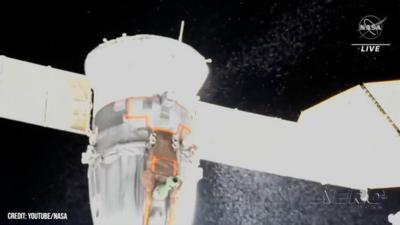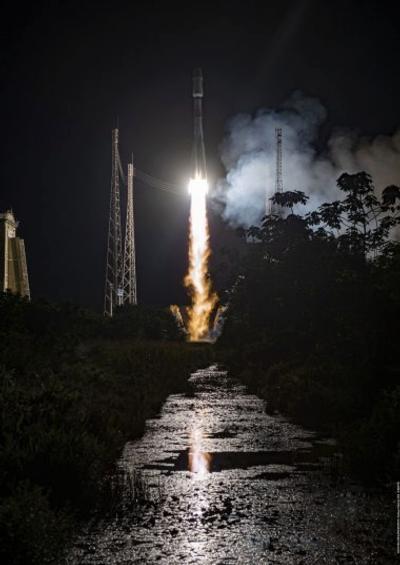Fri, Jan 13, 2023
Meteoroid Strike Damages Spacecraft, Ending Reentry Plans
Russia's space agency plans to launch a replacement Soyuz capsule to the International Space Station next month, replacing the damaged module in orbit.

The move comes after a micrometeoroid strike that perforated a portion of the MS-22 spacecraft, leading to a visible coolant leak from the outside. The capsule could no longer regulate interior temperatures, projected to creep north of 100º during reentry. With such damage, a trip back to Earth aboard the Soyuz is impossible, stranding the personnel in orbit. A new MS-23 Soyuz will be launched on February 20 from the Baikonur Cosmodrome in Kazakhstan. Luckily for the team, the replacement was already slated for launch next March, so advancing the schedule by a month is a relatively minor change of plans.

The new spacecraft will offer NASA and Roscosmos astronauts both a safe capsule and a ride home for those who could conceivably have been left stranded on the station in the event of an emergency. Since the December 14th coolant leak, the astronauts on the station have only had the SpaceX Dragon as a lifeboat - meaning only 5 of the 7 on the station could count on a safe return to earth. The new capsule will likely be used to return astronauts Frank Rubio, Sergey Prokopyev, and Dmitry Petelin, but staff says that there's a good amount of wiggle room as to when such a voyage would occur.
Rubio & co. will most likely wait a few extra months, since MS-23's fresh replacement crew will not be accompanying their Soyuz to the station. They'll now wait for MS-24 to be completed. Their original 6-month mission began in September of 2022, meaning that they could well be up in space for a year before their relief crew is ready for launch. NASA is weighing delays to its own Crew-6 launch in mid-February to possibly help Roscosmos balance out their launch schedules for greater efficiency.
Of interest is that MS-23 will have to use MS-22 as a donor 'car' of sorts. The cosmonauts will take their custom seat liners, Sokol entry suits, and gear to their new ride home before sending it back to Earth uncrewed.
More News
From 2023 (YouTube Edition): "Ain’t Your Daddy’s Super Cub”—Don Wade Co-owned by Don and Ron Wade—the former of Don’s Dream Machines, a storied >[...]
Pilot-Rated Passenger Reported That The Pilot Did Not Adequately “Round Out” The Landing Flare And The Airplane Bounced And Yawed To The Right Analysis: The pilot state>[...]
Dead Reckoning Dead reckoning, as applied to flying, is the navigation of an airplane solely by means of computations based on airspeed, course, heading, wind direction, and speed,>[...]
Aero Linx: Lake Amphibian Club This website is created and sponsored by the Lake Amphibian Club, to help spread the word about these wonderful, versatile amphibians that can land j>[...]
“I am deeply honored to be sworn in as NASA administrator. NASA’s mission is as imperative and urgent as ever — to push the boundaries of human exploration, ignit>[...]
 Classic Aero-TV: In Praise of Alabamas Patriot Aircraft USA
Classic Aero-TV: In Praise of Alabamas Patriot Aircraft USA NTSB Final Report: Cirrus Design Corp SR22
NTSB Final Report: Cirrus Design Corp SR22 ANN's Daily Aero-Term (12.21.25): Dead Reckoning
ANN's Daily Aero-Term (12.21.25): Dead Reckoning ANN's Daily Aero-Linx (12.21.25)
ANN's Daily Aero-Linx (12.21.25) Aero-News: Quote of the Day (12.21.25)
Aero-News: Quote of the Day (12.21.25)




